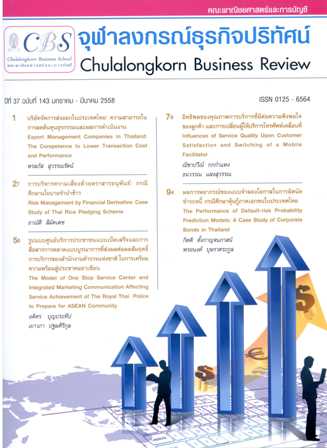การบริหารความเสี่ยงด้วยตราสารอนุพันธ์: กรณีศึกษานโยบายจำนำข้าว
Main Article Content
Abstract
บทคัดย่อ
การป้องกันความเสี่ยงด้วยตราสารอนุพันธ์มักจะถูกนำมาใช้ในการป้องกันปัจจัยเสี่ยงเดียวด้วยการกำหนด Optimal Hedge Ratio ของสัญญาอนุพันธ์ที่มีสินทรัพย์มูลฐานใกล้เคียงกับสินทรัพย์ที่ต้องการป้องกันความเสี่ยง การศึกษานี้เสนอวิธีการคำนวณ Optimal Hedge Ratio เพื่อป้องกันความเสี่ยงพร้อมกันสองปัจจัย โดยใช้นโยบายรับจำนำข้าวของรัฐบาลไทยในช่วง พ.ศ. 2540 ถึง พ.ศ. 2556 เป็นกรณีศึกษา ผลการป้องกันความเสี่ยงพบว่าการใช้ตราสารอนุพันธ์สามารถป้องกันการขาดทุนที่เกิดจากโครงการได้ อย่างไรก็ตามหากรัฐบาลกำหนดให้ราคารับจำนำอยู่ที่ระดับ 1.5 เท่าของราคาตลาด ต้นทุนการป้องกันความเสี่ยงจะสูงถึงประมาณ 30% ของราคารับจำนำ
คำสำคัญ: บริหารความเสี่ยง ตราสารอนุพันธ์ จำนำข้าว
Abstract
Using financial derivative to manage risk usually deals with one risk factor due to the complexity of calculating the optimal hedge ratio. This study shows how to calculate the optimal hedge ratio to manage two market risks simultaneously. The study illustrates by the case study of Thai rice pledging scheme during 1997-2013. The results show that the derivatives can be used effectively to mitigate loss. If the pledging price is set at 1.5 times of the spot price, however, the hedging cost will be as high as 30% of the pledging price.
Keywords: Risk Management, Financial Derivative, Rice Pledging SchemeArticle Details
Opinions and discussions in papers published by the Creative Business and Sustainability Journal (CBSJ) are deemed as personal opinions and the responsibility of the writers. They are not the opinions or responsibility of the Chulalongkorn Business School of Chulalongkorn University.
Papers, content, information etc. appearing in the Journal are deemed to be the copyright property of the Chulalongkorn Business School of Chulalongkorn University. Anybody or any organization that wishes to publish any part of them or use them in any way must obtain written permission from the Chulalongkorn Business School, Chulalongkorn University.


